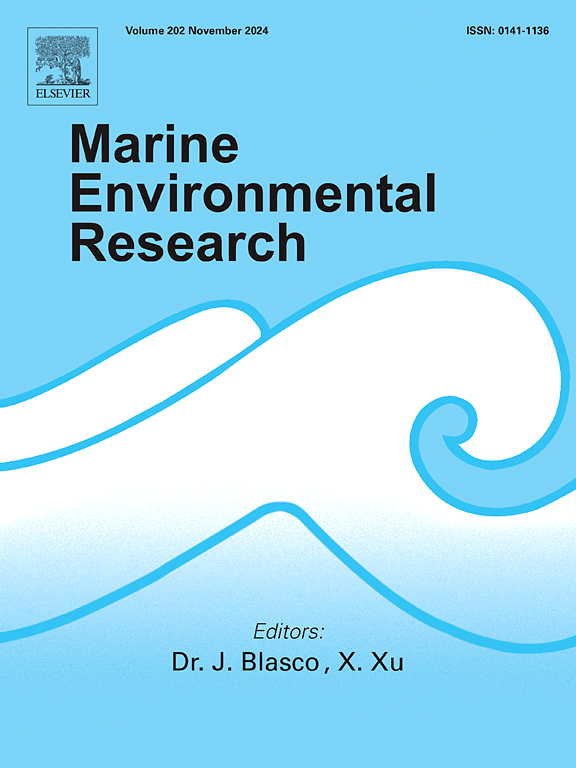Environmental DNA analysis of phytoplankton biodiversity and seasonal succession in a marine ranching area around Nan'ao Island, southern China
IF 3
3区 环境科学与生态学
Q2 ENVIRONMENTAL SCIENCES
引用次数: 0
Abstract
The coastal waters surrounding Nan'ao Island serve as important areas for marine ranching in southern China. In this study, we examined the structure and seasonal succession of the phytoplankton community in this region using an environmental DNA (eDNA) metabarcoding approach. Across four seasons, we identified 6154 eukaryotic phytoplankton amplicon sequence variants (ASVs), with 510 known species annotated. The summer community was dominated by diatoms, primarily warm-water species such as Chaetoceros tenuissimus and Leptocylindrus sp. By contrast, dinoflagellates prevailed in other seasons, with Dinophyceae being the main group in spring and winter and Syndiniales in autumn. The biodiversity and stability of the communities were found to be the highest in spring and lowest in summer. Summer upwelling and winter Zhe-Min coastal currents led to significant seasonal changes in environmental conditions across habitats. NMDS analysis revealed that temperature, salinity, and ammonium nitrogen were the main factors driving community succession, while RDA analysis showed that pH and nutrient concentrations were the primary factors contributing to spatial differences in community distribution. In addition, we identified 52 harmful algal bloom species, among which, toxic species such as Karlodinium veneficum and Dinophysis acuminata pose the greatest threat in spring, potentially causing toxin accumulation or even mortality in farmed fish and shellfish. The seasonal eDNA data obtained in this study will contribute to gaining a better understanding of the successional dynamics of phytoplankton communities and their biodiversity in response to the influence of multiple stressors in coastal waters.
南澳岛海洋牧区浮游植物多样性及季节演替的环境DNA分析
南澳岛周边海域是中国南方重要的海洋牧场。本研究采用环境DNA (eDNA)元条形码方法研究了该地区浮游植物群落的结构和季节演替。在四个季节中,我们鉴定出6154个真核浮游植物扩增子序列变异(asv),其中510个已知物种被注释。夏季群落以硅藻为主,以细毛毛藻、细毛毛藻等暖水物种为主。其他季节以甲藻为主,春、冬季以甲藻为主,秋季以双鞭毛虫为主。群落多样性和稳定性在春季最高,夏季最低。夏季上升流和冬季浙闽海流导致各生境环境条件的显著季节性变化。NMDS分析显示温度、盐度和铵态氮是影响群落演替的主要因素,RDA分析显示pH和养分浓度是影响群落空间分布差异的主要因素。此外,我们还鉴定出52种有害藻华,其中春季危害最大的是Karlodinium veneficum和Dinophysis acuminata等有毒藻华,可能会导致养殖鱼类和贝类的毒素积累甚至死亡。本研究获得的季节性eDNA数据将有助于更好地了解沿海水域浮游植物群落及其生物多样性在多种应激因素影响下的演替动态。
本文章由计算机程序翻译,如有差异,请以英文原文为准。
求助全文
约1分钟内获得全文
求助全文
来源期刊

Marine environmental research
环境科学-毒理学
CiteScore
5.90
自引率
3.00%
发文量
217
审稿时长
46 days
期刊介绍:
Marine Environmental Research publishes original research papers on chemical, physical, and biological interactions in the oceans and coastal waters. The journal serves as a forum for new information on biology, chemistry, and toxicology and syntheses that advance understanding of marine environmental processes.
Submission of multidisciplinary studies is encouraged. Studies that utilize experimental approaches to clarify the roles of anthropogenic and natural causes of changes in marine ecosystems are especially welcome, as are those studies that represent new developments of a theoretical or conceptual aspect of marine science. All papers published in this journal are reviewed by qualified peers prior to acceptance and publication. Examples of topics considered to be appropriate for the journal include, but are not limited to, the following:
– The extent, persistence, and consequences of change and the recovery from such change in natural marine systems
– The biochemical, physiological, and ecological consequences of contaminants to marine organisms and ecosystems
– The biogeochemistry of naturally occurring and anthropogenic substances
– Models that describe and predict the above processes
– Monitoring studies, to the extent that their results provide new information on functional processes
– Methodological papers describing improved quantitative techniques for the marine sciences.
 求助内容:
求助内容: 应助结果提醒方式:
应助结果提醒方式:


